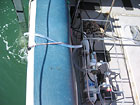

 | |||||||
|
|
Journals 2004/2005Leesa Wingo
July 13, 2004 Today started with a tour of the facilities. I passed the safety-driving test, and checked out our research vessel, the Sigma T, a refitted Fishing vessel the U.S.G.S. received from the State of Alaska, who got it in a fishing permit buyout. It was re-rigged to handle the scientific equipment necessary for oceanographic studies. The Acoustic Doppler Current Profiler (ADCP), sends sound waves down to bounce off the bottom of the ocean and "listens" to them come back up. This information is fed into a computer that is able to subtract out the speed of the boat, and can tell you the speed and direction of the currents at any depth in the water column under the boat. (Click on thumbnail below for full version pop-up) A Conductivity Temperature Density probe (CTD) is used to measure the salinity, light penetration, sediment size and amount, and density. The Sigma-T has two CTDs on board. One is specially rigged to take surface readings as water is pumped through it as we cruise along at 3 knots or less. The other is attached to a block and tackle that allows the to be lowered to depths of up to 300 meters at a constant rate. This allows for collection of consistent data of the water column. The data are downloaded into a computer program called ARCVIEW, a specially designed GIS program that is specifically programmed for Glacier Bay. It gives the scientists a 3-dimentional view of the bay's basins from any angle, examining any parameter. (To see a complete explanation about the projects involved with this tool go to http://www.absc.usgs.gov/glba/oceanography/index.htm.) (Click on thumbnails below for full version pop-up) Survival suits were donned and I looked like a cross between Orange Gumby and the Blob! It was important to know how to zip in and up if needed though. (Click on thumbnail below for full version pop-up) Ended the day with exposure to the library and how to look up Government scientific papers using the search engine, "Endnote." Return to Journals Index |
||||||



